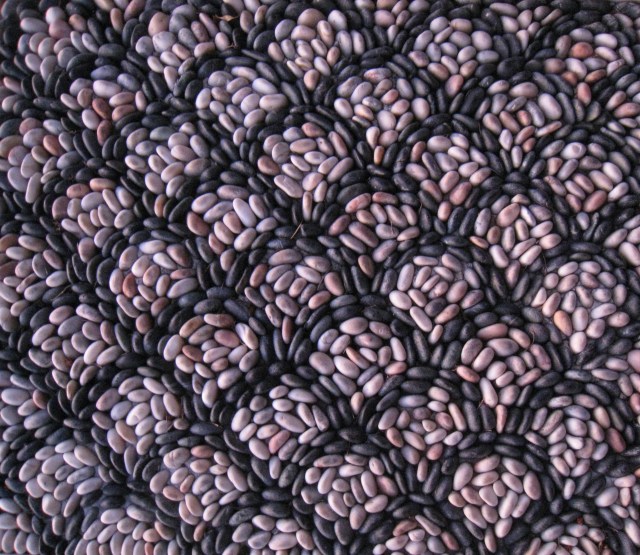Before darkness fell over the monastery, we had some time left to have a closer look at the ossuary or osteofilakio.
Just outside the gate you will find a fine terrace overlooking the sea, where pilgrims have a talk with the monks and smoke a sigarette. Behind the open window there is a small shop, selling religious things.
 The monastery Dionysiou with the terrace on the right, near the ossuary
The monastery Dionysiou with the terrace on the right, near the ossuary
 The Koimitirion – “a place to sleep” or cemetery. For us it was a place to rest. The red sign showes the path to Ag. Pavlou.
The Koimitirion – “a place to sleep” or cemetery. For us it was a place to rest. The red sign showes the path to Ag. Pavlou.
 The entrance to the Koimitirion, build in 1375, with a beautifull mozaic of pebbles on the floor.
The entrance to the Koimitirion, build in 1375, with a beautifull mozaic of pebbles on the floor.

 Behind the Koimitirion building we found the shrine,with fine copper doors. We were not sure if the doors did open….
Behind the Koimitirion building we found the shrine,with fine copper doors. We were not sure if the doors did open….
 The copper doors of the shrine.
The copper doors of the shrine.
 But they did! Looking inside we found the burial place of St. Niphon, a Patriarch of Constantinopel, who lived and died in Dionysiou.
But they did! Looking inside we found the burial place of St. Niphon, a Patriarch of Constantinopel, who lived and died in Dionysiou.
“Linked with the Dionysiou Monastery is the important figure of St Niphon, Patriarch of Constantinople, who became a monk of Dionysiou in the mid 15th century and after many vicissitudes returned to the monastery of his repentance where he lived until his death”.
 On the left side of the shrine there is a wall painting of Ag. Dionysiou
On the left side of the shrine there is a wall painting of Ag. Dionysiou
 And on the right side of the shrine a painting of Ag. Niphon himself I presume, but I am not quite sure, because his name is not on the picture. Look at very fine clothes with flowers he is wearing!
And on the right side of the shrine a painting of Ag. Niphon himself I presume, but I am not quite sure, because his name is not on the picture. Look at very fine clothes with flowers he is wearing!
 The shrine Ag. Niphonos: he does resemble St. Nicolas, with his bold head, his beard and with his book in his hands! For more information read here.
The shrine Ag. Niphonos: he does resemble St. Nicolas, with his bold head, his beard and with his book in his hands! For more information read here.
Wim, 25/7 (next time more about the cemetary)


You mentioned that there was one monk there. Is this still considered an ‘active’ monastery? Is it officially under one of the other monasteries of the Holy Mountain? Is this what I have often heard of as Old Russikon? Is there a newer Russikon?
According to our observations only one lonely monk lived in the Old Russikon. It belongs to the monastery Panteleimonos (the “New Russikon”), only 1 hour walk along the coast. All icons of the Old Russikon are in Panteleimonos and is not “active” any more.
Wim
Thanks. I love that there is such a ‘western’ looking monastery on the Holy Mountain – even if it is inactive.
@Orrologion: did you know that in fact there has been a western (benedictine) monastery on the holy mountain?
It was called “Amalfion” and its hegoumen ranked 5th (at some moment even 2nd) among the others. It was still active in 1198, but by 1287 is was so destroyed that its holdings were deeded to Megisti Lavra.
The abbey tower is still standing between Karakallou and Megisti Lavra (see http://athos.web-log.nl/athos_agios_oros_/2007/12/2279_amalfi_aga.html )
athos was open to ‘western’ monks before the schisma. this is proofed by the friendship of the founder of the lavra, athanasios, and latin monks from amalfi in the bay of morfonu. the tower is the rest of this great history and also the leftover of a ‘roman’ monastery. after the schisma monks had to leave the mountain.
the tower also called the ‘pyrgos ton amalfiton’is a fine masterpiece of an occident fortress. on the top of the tower you see the white eagle emblem of the
amalfiter.
The Great Schism wasn’t concluded in one day. Officially communion was broken in 1054, but not many people considered it to be final back then. Tensions had been growing from 800 on. It is only after the 4th Crusade that it became clear that the Patriarchate of Rome had split ways from the other ones. Even then, some “Latin Christians” were still loyal to the Orthodox Church, instead of Rome. The monks of Amalfion belonged to the former group.
A good study about Amalfion (which became (A)Molfinou, now Morfonou) can be found @ http://www.allmercifulsavior.com/Liturgy/Amalfion%20Oct%202002.pdf